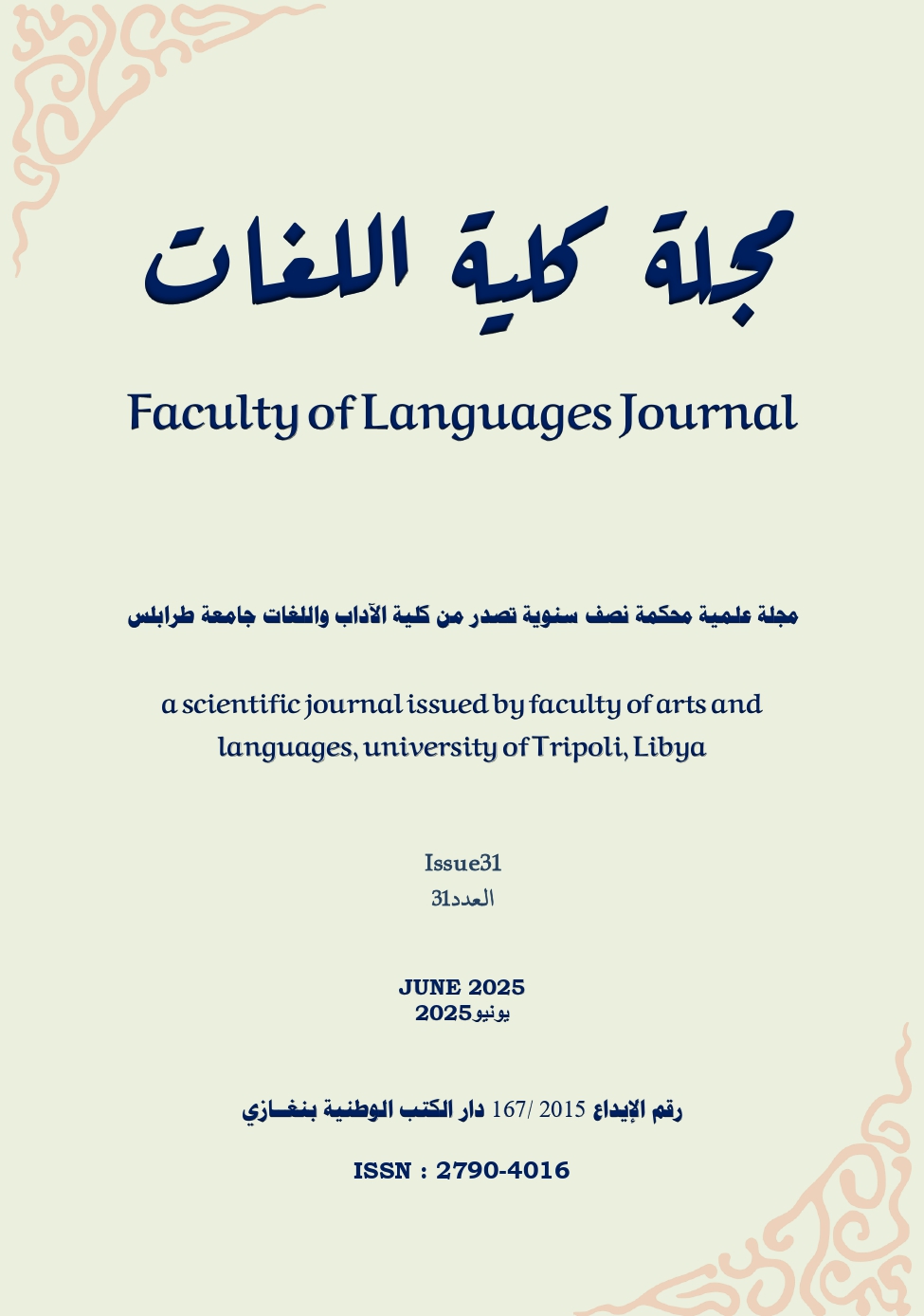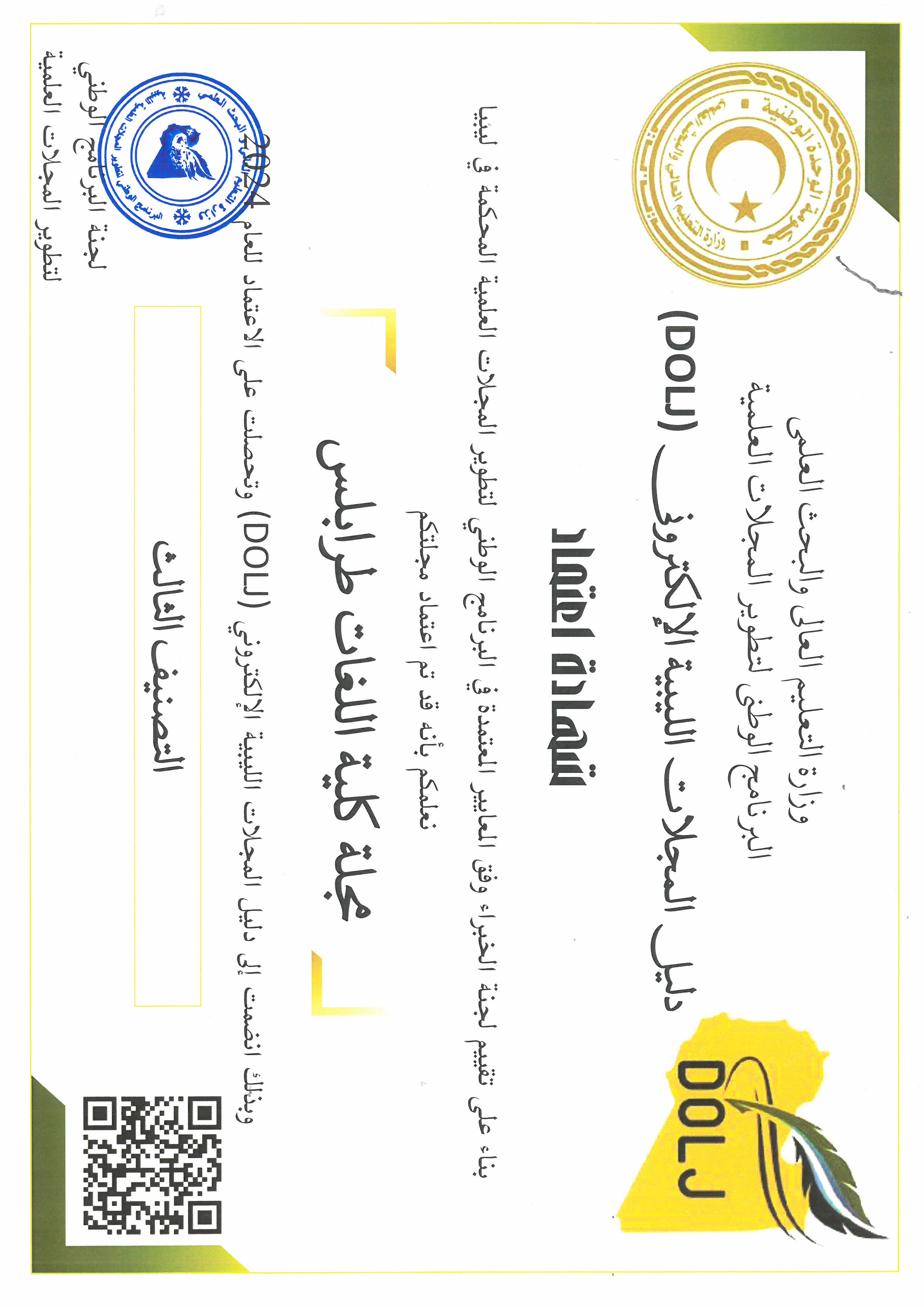Student Perspectives on Using Telegram for Learning English at the University of Tripoli Law School
الكلمات المفتاحية:
التليجرام، اكتساب اللغة، طلاب القانون، التعلم الإلكتروني، التعلم المدمجالملخص
تتناول هذه الدراسة استخدام تطبيق التليجرام كأداة تعليمية لتدريس مادة اللغة الإنجليزية في كلية القانون بجامعة طرابلس. اعتمدت الدراسة منهجية بحث مختلط، حيث تم تسجيل تجارب 44 طالبًا باستخدام استبيان لجمع البيانات، كما تم الاعتماد على الإحصاء الوصفي والتحليل الموضوعي لتحليل البيانات. أبرزت النتائج التأثيرات الإيجابية لاستخدام التليجرام في تعلم اللغة الإنجليزية بين طلاب القانون بجامعة طرابلس. بالإضافة إلى ذلك، كشفت النتائج أن واجهة المستخدم السهلة للتطبيق، وميزات التواصل المباشر، ومشاركة الوسائط المتعددة، ساهمت بشكل كبير في تعزيز تدريس اللغة. كما أظهرت النتائج أن دمج التليجرام في العملية التعليمية يسهم في تحديث التعليم من خلال تعزيز التواصل وتحسين التجارب الأكاديمية على الرغم من التحديات التي قد تواجه. علاوة على ذلك، دعمت النتائج تطبيق التليجرام في بيئات التعلم المدمج لتقليل الحواجز واللحاق بالدول الأخرى التي تستفيد من التقنيات التعليمية في نظمها التعليمية. ونظرًا للمساهمات القيمة التي يقدمها التليجرام للمعلمين والطلاب، أوصت الدراسة بشدة بدمج في العملية التعليمية.
المراجع
Aladsani, H. K. (2021). University students' use and perceptions of Telegram to promote effective educational interactions: A qualitative study. International Journal of Emerging Technologies in Learning, 16(9), 182-197.
Al-Hawari, M., &Mouakket, S. (2010). The influence of technology acceptance model (TAM) factors on students' e-satisfaction and e-retention within the context of UAE elearning. Education, Business and Society: Contemporary Middle Eastern Issues, 3(4), 299-314.https://doi.org/10.1108/17537981011089596
AlMohaya, F. L. (2022). The Impact of Telegram on Syntactic Complexity of the Saudi Female EFL Undergraduates' Argumentative, Classification, and Reaction Essays. Arab World English Journal (January 2022) Theses ID, 282.
Asmara, E., & Ratmono, D. (2021). The effect of perceived usefulness, perceived ease of use on attitudes and interest in using regional financial management information systems. In Proceedings of the IAPA Annual Conference 2021: Governance and Public Policy in the Society 5.0. Institute of Advanced Engineering and Science.
Aspers, P., & Corte, U. (2019). What is qualitative in qualitative research? Qualitative Sociology, 42(2), 139-160.
Azizpour, S. (2021). Transition from face-to-face to online instruction during the COVID-19 pandemic: An exploration of Iranian EFL university lecturers' attitudes. Research Square.https://doi.org/10.21203/rs.3.rs-658850/v1
Bates, T. (2019). Teaching in a digital age: Guidelines for designing teaching and learning (2nd ed.). BCcampus. Retrieved fromhttps://pressbooks.bccampus.ca/teachinginadigitalagev2/
Bista, K., & Glass, C. (2015). Enhancing student engagement using social media in the teaching of undergraduate education courses. Journal of Educational Technology Development and Exchange, 8(1), 1-14.
Chinnery, G. M. (2006). Emerging technologies going to the MALL: Mobile assisted language learning. Language Learning & Technology, 10(1), 9-16.
Creswell, J. W. (2012). Educational research: Planning, conducting, and evaluating quantitative and qualitative research (4th ed.). Pearson.
Creswell, J. W. (2014). Research design: Qualitative, quantitative, and mixed methods approaches (4th ed.). Sage Publications.
Harb, F., Al-Shredi, N., Balhouq, H., & Ethelb, H. (2022). The Role of Critical Thinking in Enhancing EFL MA Surdents’ Academic Writing Outcomes: A Survey Study. Faculty of Languages Journal, 1(25), 125–104.
Hew, J. J. (2017). Hall of fame for mobile commerce and its applications: A bibliometric evaluation of a decade and a half (2000–2015). Telematics and Informatics, 34(1), 43-66.
Johnson, A. (2021). Exploring the Definition and Impact of Technology in Today'sSociety. Technology Review, 25(3), 45-62.
Johnson, L., Adams Becker, S., Cummins, M., Estrada, V., Freeman, A., & Hall, C. (2016). NMC Horizon Report: 2016 Higher Education
Kovtun, O., Mohylna, T., & Burov, O. (2021). Exploring the Effectiveness of Telegram Chatbot as an Educational Tool in Blended Learning Environment. International Journal of Emerging Technologies in Learning (iJET), 16(5), 240-255.
Kumar, A., & Mishra, A. (2021). Digital Learning Tools and Platforms for Education: Classification, Benefits, and Challenges. Journal of Educational Technology, 18(2), 69-86.
Lazar, I. M., Panisoara, G., &Panisoara, I. O. (2020). Digital technology adoption scale in the blended learning context in higher education: Development, validation and testing of a specific tool. PLoS ONE, 15(7), e0235957. https://doi.org/10.1371/journal.pone.0235957
Legris, P., Ingham, J., &Collerette, P. (2003). Why do people use information technology? A critical review of the technology acceptance model. Information & Management, 40(3), 191-204.https://doi.org/10.1016/S0378-7206(01)00143-4
Mahzoun, F. E., &Zohoorian, Z. (2019). Employing Telegram application: Learners' attitude, vocabulary learning, and vocabulary delayed retention. European Journal of Foreign Language Teaching.
Means, B., Toyama, Y., Murphy, R., Bakia, M., & Jones, K. (2010). Evaluation of evidencebased practices in online learning: A meta-analysis and review of online learning studies. U.S. Department of Education, Office of Planning, Evaluation, and Policy Development.
Omar, A.A., Harb, F.E., Al-Shredi, N., & Ethelb, H. (2022). Exploration of EFL Freshman Law Students’ Attitudes on Telegram Messenger Usability in a Legal Terminology Course. Theory and Practice in Language Studies, 12(12), pp. 2519-2526,
Percival, J., & Percival, N. (2009). A case of a laptop learning campus: How do technology choices affect perceptions? ALT-J, Research in Learning Technology, 17(3), 173-186.
Prensky, M. (2001, September). Digital Natives, digital immigrants Part 1. On The Horizon, 9(5), 1-6. doi: 10.1108/10748120110424816.
Siemens, G. (2005). Connectivism: A learning theory for the digital age. International Journal of Instructional Technology and Distance Learning, 2(1), 3-10.
Smith, J., & Johnson, M. (2020). Understanding Digital Learning: A ComprehensiveOverview. Journal of Educational Technology, 15(2), 45-62.
Statista. (2020). Number of apps available in leading app stores as of Q1 2020. Retrieved from https://www.statista.com/statistics/276623/number-of-apps-available-in-leading-app-stores/ Statista. (2022). Number of smartphone users worldwide from 2016 to 2021.https://www.statista.com/statistics/330695/number-of-smartphone-users-worldwide/
Suwartono, D. (2014). Dasar-Dasar MetodologiPenelitian (1st ed.). Yogyakarta, Indonesia: Penerbit Andi.
Topping, K., Douglas, W., & Robertson, D. (2020). The Effectiveness of Online and Blended Learning from Schools: A Scoping Review. University of Dundee. Retrieved from https://discovery.dundee.ac.uk/portal/files/51952060/scoping_review.pdf
Wakerly, J. F. (2018). Digital design: Principles and practices (5th ed.). Pearson.
Warschauer, M., & Matuchniak, T. (2010). New technology and digital worlds: Analyzing evidence of equity in access, use, and outcomes. Review of Research in Education, 34(1), 179-225. https://doi.org/10.3102/0091732X09349791
Wiranegara, D. A., &Hairi, S. (2020). Conducting English learning activities by implementing Telegram group class during COVID-19 pandemic. Journal of English for Academic and Specific Purposes (JEASP), 3(2), 104-114.
Xodabande, I. (2017). The effectiveness of social media network Telegram in teaching English language pronunciation to Iranian EFL learners. Cogent Education, 4(1), 1–14.
Zhao, K. (2021). Sample representation in the social sciences. Synthese, 198(10), 9097-9115

التنزيلات
منشور
كيفية الاقتباس
إصدار
القسم
الرخصة
الحقوق الفكرية (c) 2025 Faculty of Languages Journal-Tripoli-Libya

هذا العمل مرخص بموجب Creative Commons Attribution 4.0 International License.
 https://orcid.org/0009-0002-8251-5878
https://orcid.org/0009-0002-8251-5878




